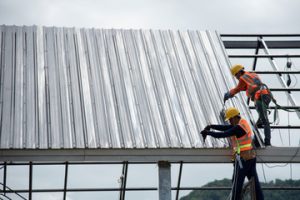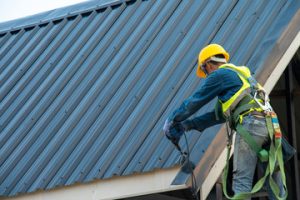A roof is more than a barrier; it is the first shield against nature’s forces. It protects everything beneath it from wind, rain, heat, and time. Yet even the strongest structures have limits, and every roof eventually reaches a point where repair is no longer enough. Roof replacement becomes not just a choice but a necessity for safety, efficiency, and long-term value.

Replacing a roof is far more intricate than simply removing old materials and installing new ones. It is a process rooted in assessment, planning, and precision. Every decision—from materials to timing—affects how well the new roof performs over decades. This complexity turns what seems like a routine project into a carefully choreographed construction effort.
The journey begins with a thorough evaluation. Professionals inspect for structural weaknesses, moisture intrusion, and hidden damage that may compromise the integrity of the building. These assessments often reveal issues invisible from the ground, such as rotting decking or deteriorated underlayment. Addressing these problems early ensures the new roof rests on a solid foundation.
Timing plays a crucial role in roof replacement. Waiting too long can lead to leaks, insulation loss, and interior damage that multiply costs. Replacing too soon, however, wastes resources and shortens the lifespan of existing materials. Striking the right balance requires experience and an understanding of how different roofing materials age under specific conditions.
The removal phase is one of the most challenging parts of the process. Old shingles, tiles, or panels must be stripped away without harming the underlying structure. This stage often uncovers hidden damage that was masked by the surface layers. Any discovered issues, such as warped decking or compromised fasteners, must be repaired before installation continues.
Modern roof replacement emphasizes energy efficiency as much as durability. Materials today are designed not only to withstand weather but also to reflect heat, improve insulation, and reduce energy consumption. Choosing the right material can significantly lower cooling and heating costs over the roof’s lifespan. These advancements make replacement an opportunity to upgrade the entire building’s performance.
Ventilation and moisture control are critical elements that often go overlooked. A poorly ventilated roof traps heat and moisture, accelerating material decay and encouraging mold growth. During replacement, professionals ensure that air can circulate properly through the attic or roof cavity. This helps regulate temperature, prevent condensation, and extend the life of the new installation.
Every detail of installation must align with precise standards. From nail placement to flashing angles, small mistakes can lead to big problems. Poor workmanship can cause leaks, structural stress, or premature failure even with the best materials. Skilled installers follow strict protocols to ensure the system works as a cohesive unit, sealing out water while allowing natural expansion and contraction.
Weather conditions are another vital consideration. Replacing a roof in the wrong season or under poor conditions risks compromising adhesion, sealing, and structural performance. Professionals schedule installations during periods of stable weather whenever possible. This reduces the chance of moisture intrusion during construction and ensures adhesives and sealants cure properly.
Beyond function, roof replacement is also a chance to redefine a building’s aesthetic. Modern roofing materials come in a variety of textures, colors, and profiles that can dramatically change a property’s appearance. This visual transformation often enhances curb appeal and increases property value. A well-chosen design blends durability with architectural harmony.
Safety is paramount throughout the replacement process. Workers operate at height, often on steep slopes and in changing weather conditions. Proper harnessing, scaffolding, and protective gear are essential to prevent accidents. Adherence to safety standards ensures that both workers and occupants remain protected throughout the project.
Roof replacement also carries environmental implications. Old roofing materials, especially asphalt shingles, can contribute significantly to landfill waste. However, many modern projects prioritize recycling and repurposing old materials. Sustainable practices reduce environmental impact and align construction with eco-friendly principles.
Costs vary widely depending on materials, design complexity, and labor requirements. While some may see roof replacement as an expensive undertaking, it is more accurately viewed as a long-term investment. A properly installed roof provides decades of protection and efficiency, often recouping its cost through energy savings and reduced maintenance. Planning ahead financially helps avoid rushed decisions that could compromise quality.
Technological innovations are reshaping the future of roofing. Advanced membranes, self-sealing materials, and integrated solar systems are now part of replacement options. These technologies not only improve durability and performance but also add new functionality, turning the roof into an active component of the building’s infrastructure. They signal a shift from passive protection to active contribution.
Climate considerations also influence replacement strategies. In regions with heavy rain, enhanced waterproofing and drainage systems are critical. In hot climates, reflective coatings and heat-resistant materials help regulate indoor temperatures. The ideal roof is always tailored to its environment, balancing resilience with comfort.
The process doesn’t end once the new roof is installed. Post-installation inspection ensures every detail meets quality standards. Professionals check for proper sealing, secure fasteners, and balanced ventilation. This final review catches potential issues before they evolve into costly repairs, guaranteeing that the new system performs as intended.
Roof replacement also provides an opportunity to integrate additional upgrades. Adding insulation, installing skylights, or reinforcing structural supports can all be done more easily during the replacement process. This approach maximizes the return on investment and prepares the building for future needs. Each added feature enhances functionality and long-term value.
Homeowners and property managers should view roof replacement as part of broader property stewardship. Like any major system, a roof requires attention, planning, and periodic renewal. Ignoring its condition risks cascading damage to walls, insulation, and foundations. A proactive approach preserves both structural integrity and financial stability.
The importance of professional expertise cannot be overstated. Roof replacement demands specialized knowledge of materials, engineering principles, and local building codes. Attempting it without proper training can lead to structural failure, warranty voiding, or safety hazards. Experienced professionals ensure compliance, quality, and peace of mind.
In the bigger picture, a new roof does more than protect against the elements. It enhances comfort by stabilizing indoor temperatures, reduces utility costs, and contributes to a building’s sustainability goals. It also plays a crucial role in property value, often influencing buyers’ decisions as much as interior features do. Its significance extends beyond structure into lifestyle and financial well-being.
The lifespan of a new roof depends heavily on maintenance. Regular inspections, cleaning gutters, and addressing minor issues early can extend service life by years. Neglecting maintenance, however, shortens that lifespan and increases the likelihood of costly repairs. Proactive care ensures that the investment continues to deliver returns for decades.
Ultimately, roof replacement is an act of renewal—both practical and symbolic. It represents a commitment to safety, comfort, and the future of a property. It transforms a vulnerable structure into a fortified haven capable of withstanding the elements for generations. The decision to replace is not just about today’s needs but about securing tomorrow’s resilience.
Every building tells a story, and its roof is the chapter that shields all the others. As materials evolve and techniques advance, roof replacement continues to merge science, design, and craftsmanship. It is where protection meets performance, and where the unseen layers above us quietly shape our daily lives. In replacing a roof, we do more than repair what time has worn down—we build a renewed foundation for everything beneath it.
